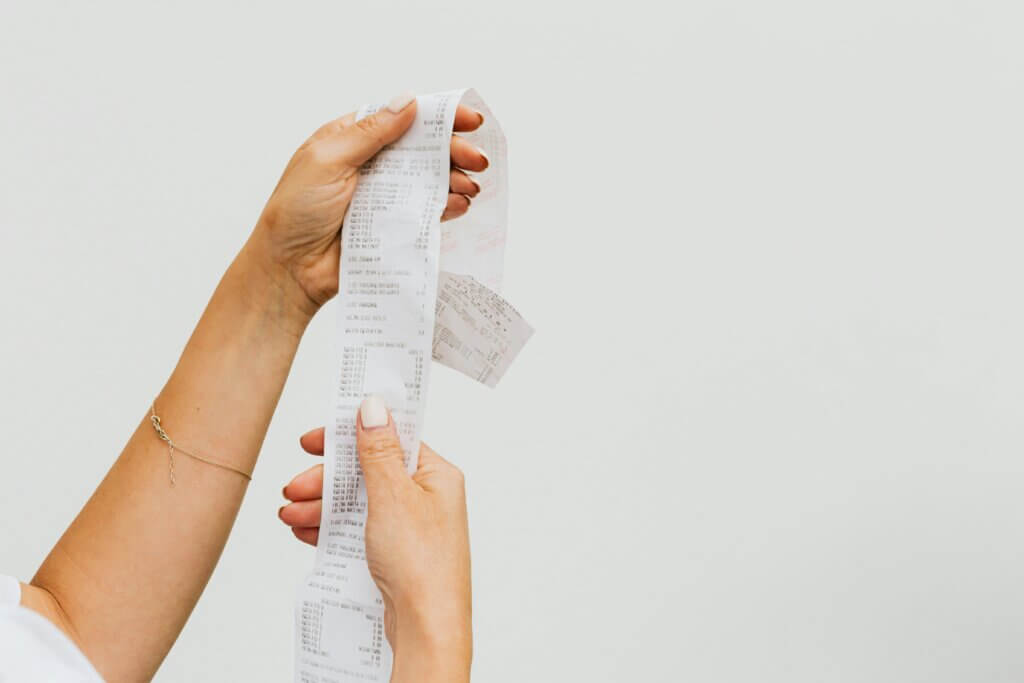When it comes to reducing everyday toxins, touching receipts might not be the first thing that comes to mind. The reality is, however, that many store receipts are coated with chemicals that can pose health risks, especially with regular exposure.
The key concern lies with substances like BPA (bisphenol A) or BPS (bisphenol S), which are commonly used in thermal paper to print receipts. BPA and BPS are endocrine disruptors, which means they can interfere with the body’s hormone systems.
So, is touching receipts bad for you? Let’s take a closer look at the potential risks and what you can do to minimize exposure.
Why receipts can be harmful
Many receipts are printed on thermal paper, which is coated with a thin layer of BPA or BPS. When the thermal paper is heated during printing, these chemicals make the ink visible on the paper.
BPA and BPS are absorbed through the skin upon contact, and studies have shown they can enter the bloodstream relatively quickly, potentially affecting hormone levels and interfering with bodily functions—which we’ll dive into next.
What research says about BPA and BPS exposure
Research has increasingly highlighted the potential health risks associated with exposure to BPA and BPS, drawing connections between these compounds and various health concerns. By understanding these risks, you can take steps to minimize your exposure to BPA and BPS:
Hormonal imbalances
BPA is an endocrine disruptor, particularly known for its ability to mimic estrogen. This mimicry can lead to reproductive issues, including altered sperm production in men and menstrual cycle irregularities in women. Prolonged exposure may also contribute to infertility. BPS, while often marketed as a safer alternative to BPA, exhibits similar hormone-disrupting properties, raising concerns about its long-term effects.
Increased skin absorption
A 2010 study published in the journal Environmental Health Perspective revealed that handling receipts coated with BPA significantly increases the absorption of the chemical through the skin. This absorption rate was found to be especially pronounced in individuals with moist skin or when lotions or hand sanitizer were applied.
Health risks for vulnerable populations
Certain groups may face heightened risks from BPA and BPS exposure. Pregnant women, infants, and individuals with existing endocrine disorders are especially vulnerable.
For example, BPA exposure during pregnancy has been linked to developmental issues in children, including behavioral problems and increased susceptibility to metabolic disorders later in life.
Associations with chronic health conditions
Studies have suggested a correlation between BPA exposure and various chronic health conditions, such as obesity, diabetes, and cardiovascular disease. Research indicates that BPA may disrupt metabolic processes, contributing to insulin resistance and weight gain.
BPS, although newer to the market, is being scrutinized for similar associations, with preliminary findings suggesting it may pose comparable risks.
Environmental impact
BPA and BPS can harm the environment as well. These chemicals can leach into soil and water, affecting wildlife. BPA contamination has been found in rivers and lakes, raising concerns about its impact on marine life and food chains.
5 Tips for reducing exposure to BPA and BPS from receipts
There are a few simple ways to reduce your contact with receipt chemicals, especially if you handle them frequently. Here are some practical tips to protect yourself:
1. Say “no, thank you” to receipts when possible
Many stores offer the option to go paperless by emailing or texting a digital receipt. Opt for this alternative whenever possible, especially if you don’t need a physical copy. This is one of the easiest ways to reduce unnecessary exposure.
2. Wash hands after handling receipts
If you handle a receipt, wash your hands immediately afterward, especially before eating or touching your face. This can help reduce the chances of BPA or BPS being transferred from your skin to your mouth or other sensitive areas.
3. Store receipts in a separate bag or envelope
Keeping receipts in a separate part of your purse or wallet minimizes direct skin contact and also prevents chemical residue from spreading to other items, like your phone or keys.
4. Wear gloves if handling receipts frequently
If your job requires you to handle a large volume of receipts, consider wearing gloves to reduce skin exposure..
5. Avoid using hand sanitizer before or after handling receipts
Studies have shown that hand sanitizers can increase BPA absorption through the skin. That’s because alcohol-based sanitizers can break down the skin’s natural barrier, which allows BPA to penetrate more easily.
Are there safer alternatives to thermal paper receipts?
As awareness around the potential risks of BPA and BPS has grown, some companies and manufacturers have started looking at safer alternatives. Here are a few options that reduce or eliminate the risks associated with traditional thermal paper:
BPA- and BPS-free receipts
Some stores now offer BPA-free or BPS-free receipts as a safer alternative. While BPS is sometimes used as a substitute for BPA, even BPS-free receipts may contain other chemicals, so it’s still wise to limit contact if possible.
Digital receipts
As mentioned earlier, digital receipts are a great alternative for reducing exposure. Many businesses, especially large retailers, now offer email or SMS receipts that provide a convenient and safe option.
Eco-friendly paper receipts
Some companies are also turning to eco-friendly paper receipts printed with soy or water-based inks. These receipts may be a bit pricier for businesses but offer a safer alternative for both employees and customers.
How to safely dispose of receipts
Receipts printed on thermal paper are not recyclable, as they contain chemicals that can contaminate the recycling process.
When disposing of receipts, throw them directly into the trash rather than recycling to prevent potential chemical contamination of other materials.
Reducing the number of receipts you take is also helpful, as fewer receipts means fewer environmental and health risks.
Final thoughts: Be mindful when handling receipts
While an occasional touch of a receipt isn’t likely to pose major health risks, reducing exposure to chemicals like BPA and BPS is a positive step toward a low tox lifestyle. By being mindful about accepting receipts, washing hands after handling them, and opting for digital alternatives, you can significantly limit your contact with these common hormone-disrupting chemicals.
If you’re a business owner, offering digital or BPA-free receipts can be a thoughtful way to create a safer environment for both your customers and employees. A few small changes in your everyday habits can make a meaningful difference, especially for those with frequent exposure.







